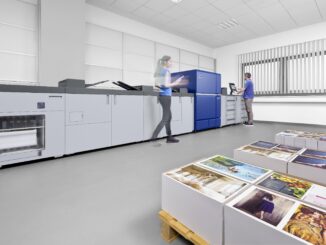
Konica Minolta announces significant new environmental goals, including aiming to make its products from more than 90% circulated resources by 2050
“When Konica Minolta published its EcoVision 2050 in 2009, the targets were in line with what were strict standards for the time. However, as the climate crisis exacerbates, these are no longer appropriate. We have therefore committed to setting stricter climate protection targets to fulfill our responsibility as a global company (with more than 39,000 employees worldwide) in regard to minimising our ecological footprint significantly. We also support our customers and suppliers in achieving their environmental goals”, explained Olaf Jonas, general manager environmental social governance at Konica Minolta Business Solutions Europe.
It aims to use more than 90% circulated resources for its products by 2050. These resources are recycled materials and biomaterials. With that goal in mind, the company aims to enable the reuse and recycling of materials as many times as possible to minimise waste and the consumption of natural resources.
As of today, its MFPs already use up to 44% and the production printing systems up to 15% recycled materials. Toner bottles use up to 61% recycled materials.
In Europe, some countries offer refurbishment programmes for MFPs to be refurbished according to strict standards. Also, part of the collected toner bottles and cartridges are refurbished and refilled throughout Europe.
In the 2021 fiscal year, 11,200 tonnes of end-of-life office equipment were taken back. Of this, 99% was recycled. As part of the World on Loan program, discarded consumables are collected and recycled in the UK.
Styrene foam is widely used but has a poorer environmental performance than other materials. Therefore, Konica Minolta has been looking for packaging solutions to replace it. For transport from its factories to Europe, in 2019 Konica Minolta developed a new air cushioning material for packaging and transporting MFPs and production printing devices.
By using the lighter, more compact air pillows, the company was able to reduce the weight of shipments by 75% and the packaging volume by 99%. In addition, it is also committed to the use of cardboard. Units shipped from the European warehouse in Emmerich to our European customers are simply shrink-wrapped on pallets.
Along with its goals towards the use of circulated resources, Konica Minolta is also committed to the United Nations Sustainable Development Goals (SDGs) and considers climate action as the most urgent area for action.
The company is continuously working to reduce its greenhouse gas emissions throughout the product life cycle and eliminate waste. In 2005, the company recorded 2,067 thousand tonnes of CO2 emissions; in 2021, the figure was 790 thousand tonnes of CO2, which is a reduction of 61%. In 2050, the company aims to reach the net zero target in Scope one, two and three.
The former CO2 reductions and the net zero goal have been, and will be, significantly achieved through energy savings. Konica Minolta prioritises as follows:
- Avoid and reduce energy consumption and greenhouse gas (GHG) emissions
- Substitute GHG-emitting power sources with renewable energy
- Compensate unavoidable GHG emissions
Specifically, the energy consumption of its printing devices has continuously decreased over the last few years. The largest energy consumption, over 60%, occurs when the toner is fixed to the paper. With the polymerised Simitri® V toner used in the bizhub i-series, the latest MFP generation, Konica Minolta has been able to reduce the fixing temperature by about 15°C compared to previous models.
Combined with a new fixing device, this helps to significantly reduce the TEC Value. The reduction in power consumption has resulted in the MFPs producing up to 25% less CO2 emissions in operation compared to previous models.
Further, Konica Minolta aims to replace fossil fuels with renewable energy because burning fuel to generate electricity produces significant amounts of greenhouse gas emissions. That is why the company has been a member of RE100 since 2019 and is committed to using 100% renewable electricity by 2050, and 30% by 2030.
As of the 2021 fiscal year, it sources eight point 8.3% of its electricity from renewable sources worldwide. Konica Minolta’s European Headquarters and 11 subsidiaries, including the UK, already use 100% renewable electricity. Two of the factories in China already use 100% renewable electricity, which means that more than 50% of the MFPs and all production printing devices for the European market are produced with renewable electricity. In addition, the European toner factory in France also uses 100% renewable electricity.
In Europe the company compensates non-avoidable emissions and supports climate protections projects aiming to replace fossil fuels by renewable energy such as wind parks with its partner Climate Partner. All projects must meet the Gold Standard VER criteria. Gold Standard VER projects go beyond climate aspects, because they also fundamentally take social aspects into account.
With the Enabling Climate Compensation programme, Konica Minolta offers its customers the ability to offset unavoidable greenhouse gas emissions for office and production printing devices. Since 2015, more than 50,000 tons of unavoidable greenhouse gas emissions were compensated.
With its visual Remote Service AIRe Link, which was introduced in 2020, Konica Minolta has been able to save around 310,760 kilometres in 8,900 customer visits across Europe from 2020 to 2022, which corresponds to 140 tonnes of greenhouse gas emissions.
Where possible, the company is trying to shift transport across Europe from air and road to rail or water. 90% of its goods transport from Rotterdam in the Netherlands to its main warehouse centre in Emmerich, Germany, are carried out on the Rhine River with barges. 40% of transport from Emmerich to Italy is already done by rail.



Be the first to comment